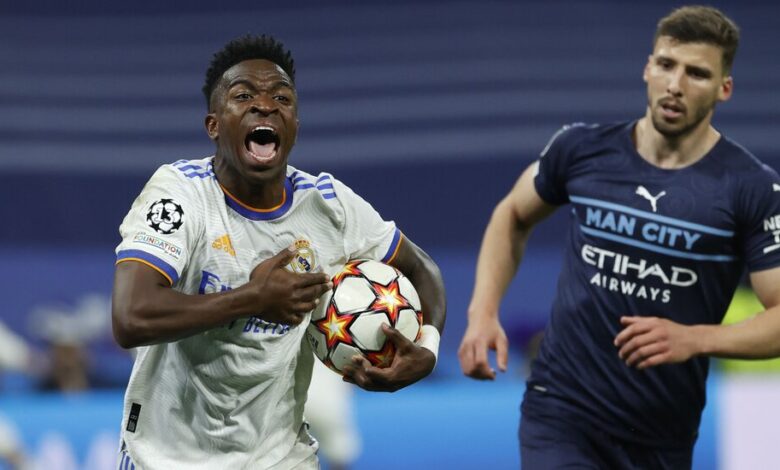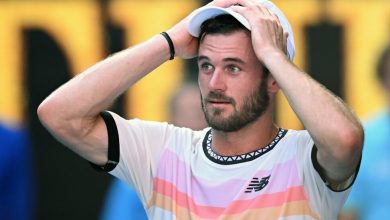What the Champions League Is Lacking

PARIS — There will be stories, of course. There are always stories. The Champions League delivers them so frequently and so reliably that it is impossible to dismiss the nagging suspicion that all of this might just be scripted, the product of some complex simulation being run from a secret lair in Nyon.
Robert Lewandowski, clad in the blue and red of Barcelona, will return to Bayern Munich, only a few weeks after forcing his exit. Manchester City’s visit to Borussia Dortmund will see Erling Haaland standing once more before its Yellow Wall, that great force of nature no longer at his back but marshaled in his face.
And there will be scenes, too. Real Madrid, the reigning and apparently perennial European champion, will walk out at Celtic Park and wince at the roar of a place that impressed Lionel Messi so much that he keeps a Celtic jersey at home as a memento, an atmosphere described by Xavi Hernández as “incomparable,” an arena where the host’s winning so much as a corner generated a noise that made Antonio Conte think “the stadium was falling down.”
That is what the Champions League does best, after all. Like its great contemporary, the Premier League, the competition is as much an iconographical phenomenon as a sporting one. Even in those years — not so long ago, even now — when its product was more noted for its caution, its risk aversion, its brutalist cynicism, its appeal endured because of the way it was packaged.
The searing lights, the swelling music and the packed stands across Europe all serve as immediately comprehensible prompts to observers and participants alike. They denote that what is unfolding is the pinnacle of the sport, the only thing that matters, the indisputable main event.
And yet, for the first time in three decades, that may not be true this year. This season’s Champions League will be a staccato one. The first two months of the tournament will bring a great rush of fixtures, six rounds of games played in nine breathless weeks, the only breather coming in the form of an unwelcome and, on some level, somewhat greedy international break.
Then the competition that has spent 30 years establishing itself as the unquestioned and unrivaled summit of the game — the place where the sport’s cutting edge is sharpened, where new ideas bubble and sizzle, where players put their talent to the ultimate test — will be suspended in uneasy hibernation, put begrudgingly on hold from November until February.
Reluctantly, the Champions League — and the constellation of Europe’s great clubs who have come to regard it as their objective and birthright — will cede the limelight to the World Cup: five prime weeks in the middle of the season handed over to international soccer, that anachronism of a bygone age, glossy club soccer’s unwelcome, ugly cousin.
There is no shortage of reasons for club soccer to resent this intrusion: the financial ramifications of losing those weeks of television real estate; the potential risk of injury to players paid not by their national associations but by the clubs; the sense that the engine of the sport is being forced to stall so that the hood can be polished.
Read More on the 2022 World Cup
- A New Start Date: A last-minute request for the tournament to begin a day earlier was only the latest bit of uncertainty to surround soccer’s showcase event.
- Chile’s Failed Bid: The country’s soccer federation had argued Ecuador should be ejected from the tournament to the benefit of the Chilean team. FIFA disagreed.
- Golden Sunset: This year’s World Cup will most likely be the last for stars like Lionel Messi and Cristiano Ronaldo — a profound watershed for soccer.
- Senegalese Pride: Aliou Cissé, one of the best soccer coaches in Africa, has given Senegal a new sense of patriotism. Next up: the World Cup.
But greater than all those, perhaps, is the unhappy reminder that, while the Champions League is the most glamorous and most exclusive club competition on the planet, it is only the most glamorous and most exclusive club competition on the planet. The qualifier — “club” — tells a story of its own. For all the money, for all the power, for all the stories and the scenes, the World Cup is still the biggest show in town.
It is worth pausing to reflect on why that might be; after all, it does not fit neatly with what we assume modern consumers — sorry, fans — want from sports. As discussed in this space a couple of weeks ago, audiences are drawn to soccer games by two factors in particular: the familiarity of the brands — sorry, teams — involved, and the stakes for which they are playing.
The World Cup, like the Champions League, delivers both in spades. There is no brand recognition quite like being a nation state, with your own seat at the United Nations and history of governmental corruption and fully equipped army, obviously. And there is no tournament quite so doused in risk as the World Cup, in which one misstep can waste four years’ work.
In every other aspect, though, the World Cup comes up short. It cannot match the Champions League for prize money, or for star power — Haaland, like Mohamed Salah and the noted nation state of Italy, will be absent from Qatar — or, most crucial, for quality. The Champions League, now, is where the finest soccer in the world is played. The World Cup, by contrast, is pockmarked by flaws.
That is unavoidable, of course. If Manchester City lacks a striker, it can go out and buy the best one it can find. Spain, as it has helpfully proved over the last several years, does not have that luxury. Like everyone else, it has to make do and mend. Its coach does not have the opportunity of endless training sessions to hone a system that might accentuate the team’s strengths and disguise its weaknesses; a few days is all that is available.
And yet, still, the World Cup possesses the quality of a Black Hole; it draws in the light from even the brightest stars around it. The first phase of the Champions League, like the early rounds of domestic soccer, will have the feel of an appetizer, for fans and players. Games will be played with an awareness that nobody wants to miss the main course.
That, perhaps, suggests the World Cup has something that the Champions League does not. That could be rarity: the fact that even the finest players might get only three shots at going to a World Cup when they can reasonably expect a dozen or so tilts at the Champions League trophy. It could be the jeopardy that is, for now, threaded into its structure. It could be good, old-fashioned patriotic fervor.
Or it might be mystery. It may be the flaws themselves that make the World Cup so appealing. It could be that the tournament’s appeal is linked to the fact that Spain could turn up and win it or be eliminated in the group stage; that France, despite the quantity of its quality, could be eliminated on penalties by Switzerland; that South Korea can beat Germany and still not qualify for the knockout rounds.
The Champions League has, over the years, lost all of that uncertainty. Every year, it feels more like a parade of the inevitable. There will be stories and there will be scenes this season, as there are every season, but they will be rooted in the same inequality that means it is already possible to be pretty certain of the identity of at least a dozen or so of the teams that will make the round of 16.
The same cannot be said of the World Cup. None of the teams are perfect — none of them can be — and so the playing field is more level. The teams that do benefit from a disparity of resources do not have the safety net of five more group games, or a second leg, or the prospect of the transfer market.
It is the flaws of the teams in the World Cup that make its appeal unrivaled. It is the uncertainty that they bring that make it the main event. It is the unpredictability that generates what the Champions League lacks, and what it might like to consider trying to capture once more.
The Death of the Group of Death
There are, now, two types of Champions League groups. One features two heavy favorites, two teams whose seasons will be defined by how deep they can advance into the competition — Paris St.-Germain and Juventus, for example — and two comparative makeweights, in the form of Benfica, say, and Maccabi Haifa.
These groups are something of a tease. The way UEFA draws the groups means that the eye is drawn to those first two names. P.S.G. and Juventus, you think: a clash of the titans. There will be genuine jeopardy here. This sensation lasts as long as it takes the observer to remember that two teams qualify from each pool, and so the games between the two resident superpowers may, in fact, mean nothing at all.
The second sort of group is more interesting. Thanks to the quirks of the seeding system, these feature just one putative contender — Liverpool, despite its early-season form, or Chelsea, say — and three relatively evenly matched opponents: Ajax, Napoli and Rangers, or A.C. Milan, Red Bull Salzburg and (at a push) Dinamo Zagreb.
In this scenario, too, the superpower invariably makes it through — that is the nature of the modern Champions League, in which we all spend an awful lot of time making sure that the thing that always happens will, in fact, happen again — but it is generally with a lower points total and a degree of gratitude that their rivals all managed to beat each other.
The sole exception to this rule of two groups comes on those occasions when there is a third kind: when one team in a group is notably weaker than all three of its opponents. That dubious honor, this year, falls to Viktoria Plzen, the Czech champion, drawn to face Barcelona, Bayern Munich and Inter Milan.
There are eight groups in this year’s Champions League. This is the only one that does not fit the pattern. This is the only one that is not wholly predictable, that might just about be described as a Group of Death, and even that is only because it is impossible to be entirely sure how secure in itself this new vision of Barcelona might be. In ordinary years, even a club as famous as Inter would find itself succumbing to the inevitable, and European soccer would be facing up to the prospect of a fall without any jeopardy at all.
Correspondence
Thanks to Jon Gilbert, first of all, for performing that most valuable of services: holding me to account for my attempt last week to hold Gary Neville to account.
“Neville was railing against Glazer parsimony,” Jon wrote. “But that was nothing to do with buying players. Neville was apoplectic at the complete lack of investment in club infrastructure. He was hugely upset about the state of Old Trafford, now a leaky rust bucket. The club lacks a leading training facility, the lack of a sporting director has stifled progress and a soccer-competent leadership team is desperately needed.”
The last couple of points were, I think, raised by last week’s newsletter, but I’ll concede the former: Neville was speaking more broadly than simply complaining that United should lavish more money in the transfer market. The decline of Old Trafford, in fact, is a pretty handy metaphor for the club as a whole: It still draws the crowds and rakes in the cash, but it is trading on memory.
A question, too, from Phil Friedman, soliciting an expansion to the suggestion that some revised version of the European Super League makes more sense for other teams from the continent than it does for the denizens of the Premier League. “Not sure I understand this thought,” Phil noted, which indicates a failure on my part to communicate with sufficient clarity.
My logic — which may, caveat emptor, be faulty — is that the Premier League’s supremacy is now ensconced; its broadcasting income will continue to spiral, and so its teams essentially have no need to seek a more glamorous competition elsewhere. Indeed, you could argue that the Premier League will become a sort of de facto Super League anyway, with every other domestic competition in Europe feeding into it.
For the elites of Germany, Spain, Italy and France (and potentially others) the only conceivable challenge to that hegemony is to join forces. A league not just boasting Bayern Munich, Barcelona, Paris St.-Germain and Juventus but also drawing on the combined populations of the countries they call home would, I suspect, be able to generate revenues that can match those on offer in England, allowing those clubs to gain access to the fortunes they so evidently believe they deserve.
That is certainly not to say its advent would be welcome, of course. Regional leagues are an idea I can get behind; losing the variety offered by each domestic tournament would be a shame. It is just that, from my vantage point, it has a certain inevitability about it, even allowing for the fatal flaw in any proposed Super League: the fact that someone would have to finish bottom.





